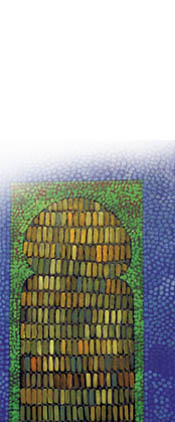
|
 |
Reproduced from: DAWN (Pakistan) February 10, 2007
The Diaspora Syndrome
By Salwat Ali
Today a considerable amount of contemporary art belongs to artists located in the Diaspora. As a practicing artist, Lubna Agha was painting her diaspora years before the term gained currency and acceptance that it now enjoys. A Fomma monograph, ‘Points of Reference’ by Marcella Nesom Sirhandi traces Agha’s aesthetic evolution and progression of her stylistic shifts but it is the soul baring details of her dislocation that bring grip to the volume.
The early years of Agha’s emergence as an artist are fairly well documented and viewers here are familiar with her white paintings but in 1981, along with her family, she moved to Sacramento, California, USA where she went through the second most important change in her artistic life. Here, after serious engagement with organic abstraction so central to her white paintings, she returned to figuration. Ali Imam had called Lubna, “an artist on the run, passing from phase to phase” but in Marcella’s text we are able to discover the reality behind the shift.
Artists are intimately associated with their immediate environment and Pakistan for Lubna was home where she was settled with her family and had friends, relatives and a successful career as a practicing artist. Sacramento was a strange new environment where the family had to make ends meet on a limited budget in cramped housing amongst strangers. “A life that was whole became fragmented” and Lubna, overwhelmed by the displacement, poured her heart out into her canvases.
Marcella narrates an incident where well known California artist Wayne Theibauld on viewing her figurative painting questioned “Why are none of your figures grounded? To which Lubna responded “I recently came from Pakistan and don’t have my bearings here yet. It’s a metaphor.” But there was more to this painting called ‘Tree of Life’ than just the lack of gravity.
The author writes that, “Her nudes were not just carefree spirits but in the grasp of an inner turmoil. Some covered their faces while others were upside down and floating. Their gestures and postures symbolized difficulty in adjusting to their surroundings. The imagery reflected Lubna’s own personal discomfort in her new home. The tree was nature, the reliable constant she had always clung to. It also represented her heritage.”
Other works of the same period like ‘Doli’, ‘Roots’ and ‘Falling’ went beyond personal dislocation to allied sentiments like nostalgia, longing for home and addressing of personal suffering through cultural statements and socio political critique pertaining to homeland issues. The most telling among these was ‘Three Days’, Lubna’s expression of the three phases of life pertaining to birth, struggle for existence and death. “The foetus and umbilical cord were the connection to her cultural heritage, the continuation of life and thread between generations. The chevron — designed trees harboured roots that provided further connections to her homeland, family and friends.”
Incorporating computer language into the painterly exercise is a common feature now but as early as the mid 1990s the Mac11 influence was manifest in Lubna’s oil painting with the computerized phrase ‘Fragmentation Disintegration’ super imposed over the painted surface.
Lubna Agha’s art was a product of her peculiar situation, a Muslim in a western environment. It manifested influences of a life dominated by career advancement, technological developments in art as well as a deep sensitivity to global politics and its affects on the Muslim population worldwide and in the subcontinent. Paintings like ‘Sarajevo’ and later the Ja-namaz series, especially ‘Ja- namaz and the White House’ and another with McDonald’s Golden Arches and still another with the IMF logo were very direct interpretations of this phenomenon.
Her current phase ‘Infinity and Oneness’ is a far cry from the cubist abstraction, semi realistic figuration and extensive recourse to symbols from nature that she formerly played with a serious intent and purpose. Lubna’s new work is defined by a desire to translate Islamic religious and cultural heritage with a fresh vision. Marcella writes that the “fresh vision had less to do with iconography and design than with process and craftsmanship.” Even though the narrative element is entirely absent from the chromatically vibrant visuals in the Infinity chapter they still have a passionate eloquence about them.
Agha is an artist with tremendous emotive capacity and Marcella Sirhindi captures this with due sensitivity in her monograph. The artist’s absence from the Pakistani art scene is also reason enough to read the volume. It completes an unfinished picture.
Salwat Ali is one of the most prolific writers on contemporary art in Pakistan. A regular critic for Dawn, The News and Newsline, she is the author of Laila Shahzada; Exploring an Inner Landscape published by the Oxford University Press. Her reviews have been singled out for their versatility and “extraordinary insight … lively wit, reader-friendly style and a command over the intricacies of art.
|
 |
 |


